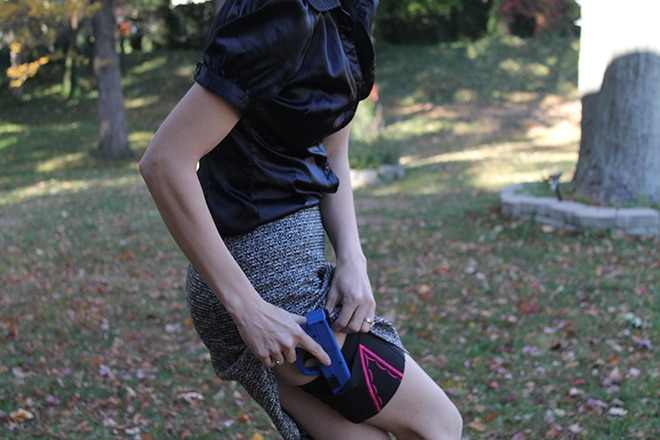
Demonstrating a draw from the Can Can Garter holster, a decent fabric option for women. (Photo: Jacki Billings)
Women are turning to firearms in droves. The NRA reports that women are the fastest growing market within the shooting industry. It’s no surprise that gear companies are now catering to this growing sect of shooters. While the “pink it and shrink it” business model has always plagued the industry, a new villain has emerged in the world of holsters.
This problem is one I’m terming chic carry. Chic carry refers to holsters and gear purely focused on fashion. The hook of these holsters is style or comfort. Safety and efficiency are often an afterthought.
In a sea of chic carry where fashion precedes function, how do we separate the good from the bad? Whether testing gear for Guns.com or looking for carry options for myself, I keep a few rules in mind when looking at holsters.
Rule number one: A good holster will retain your firearm.

Lacey numbers might spice up your wardrobe, but a good holster will pride function over fashion. (Photo: Jacki Billings)
While concealed carrying I should be able to run, jump, stand on my head and yes, even go to the bathroom without having the firearm flop out. The whole point of a holster is to hold your firearm. If the rig you’re eyeing can’t promise that, keep looking.
A molded holster, that is one that is specifically created for your make/model of gun, is what I recommend. Though molded holsters retain well, they can be bulky. In times of deep concealment, some fabric holsters do meet the bar of retention. When selecting a fabric style for deep concealment, ensure the rig has some means of keeping the firearm in place. Whether that be with magnets or by a velcro retention strap, your firearm should never unintentionally flop or fall out of the holster.
Rule number two: A good holster will protect the trigger
It’s the dirty word you don’t want to hear: negligent discharge. Everyone thinks they’re immune, but in reality it can happen to the best of us. While remaining aware and never feeling complacent are both key ingredients to preventing NDs, holsters play a large role in safety as well.

The trigger guard is completely covered in this Guardian Angel Mini IWB holster. (Photo: Jacki Billings)
The most dangerous time for most concealers comes at re-holstering. This is where we tend to get sloppy. Fingers slip in the guard, triggers are engaged and guns go boom. A good holster covers the trigger area while preventing the trigger from being engaged.
No matter how pretty or comfortable a rig might be, if it’s not safe it’s not worth your money. When shopping, carefully inspect the area around where the trigger resides. If the fabric or mold allows objects to depress the trigger or pass inside the guard, pass on that holster and keep up the search.
Rule number three: A good holster will allow the wearer to draw efficiently and cleanly while preventing access to unauthorized persons
The first concept here is the idea that holsters are meant to give us access to efficiently draw and present the firearm. To me, this means no fumbling, no slipping, no snagging and no fishing around for my holster.
If the retention strap requires two hands or is too difficult to manipulate, the holster isn’t holding up to its end of the bargain. If the firearm is so deeply concealed that I have to go on an expedition to find it, it serves me no good in a fight.
When the average self-defense encounter is decided in a matter of minutes, every second counts. I need to know where my gun is and I need to be confident that I can get to it.
The other side of this rule is that no unauthorized persons should have access to the gun. There’s been a rash of news stories detailing the outcomes of kids taking firearms out of unsafe holsters. Spoiler alert, it doesn’t end well.
The holsters you should be buying are ones that keep the gun secured on you the entire time.
Other considerations
The guidelines I use for holsters are not pick and chose. A good carry rig will encompass every one of those rules.

Crossbreed and I.C.E.’s Modular Belly Band securely holds the SIRT training pistol in place using molded kydex. (Photo: Jacki Billings)
While the above drive my decision to ultimately give the thumbs up or down to gear, when selecting my own carry gear I also take into consideration comfort and the intended purpose of the rig. If the holster meets all the requirements above but uses a material that scratches me or pokes me, I’m not going to wear it every day. I will instead opt for an option that meets the criteria while being comfortable.
It’s also important to keep in mind why you are buying a holster. If it’s to work with Sunday church clothes, a fabric holster could offer the deeper concealment you need to work with skirts or dresses. On the other hand, if you’re taking a concealed carry class that requires the use of holsters, you’ll want a molded one that allows for clean draws and easy re-holstering.
Final thoughts
In the fight for my life, I won’t care if the color on my gun matches my holster or how sexy it makes me feel and neither will you. Invest in a good holster that works with you not against you. Function over form, that’s my mantra.
Please, ladies, while holster shopping don’t give in to promises of fun, flirty or fashionable. The only f-word you need is function.
The post 3 rules for choosing a women’s holster appeared first on Guns.com.
